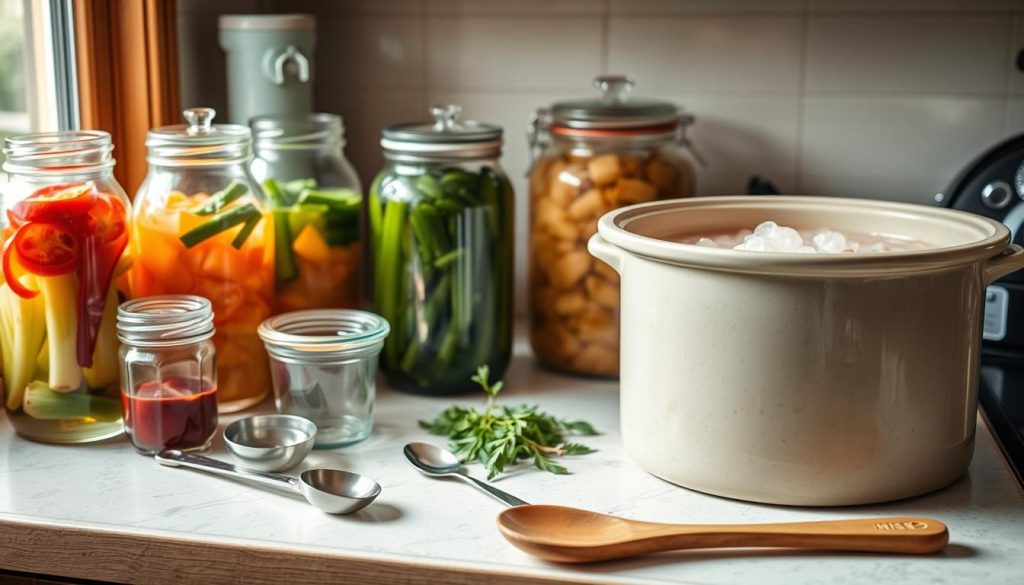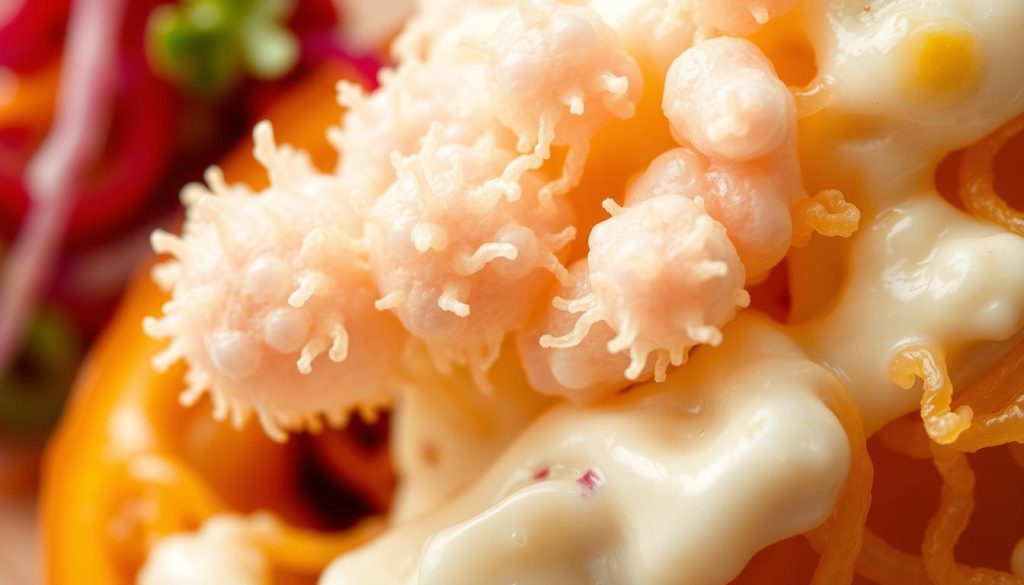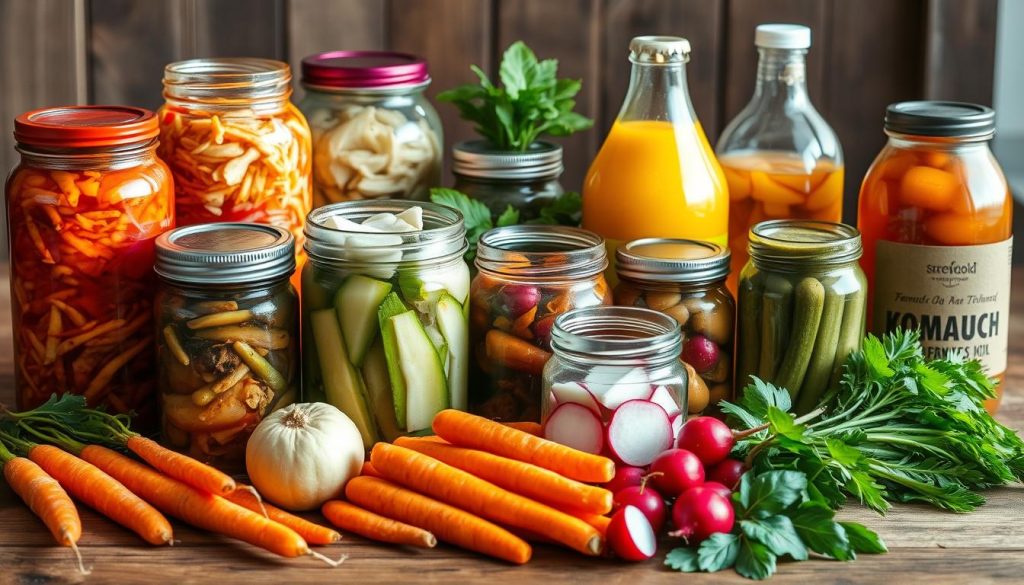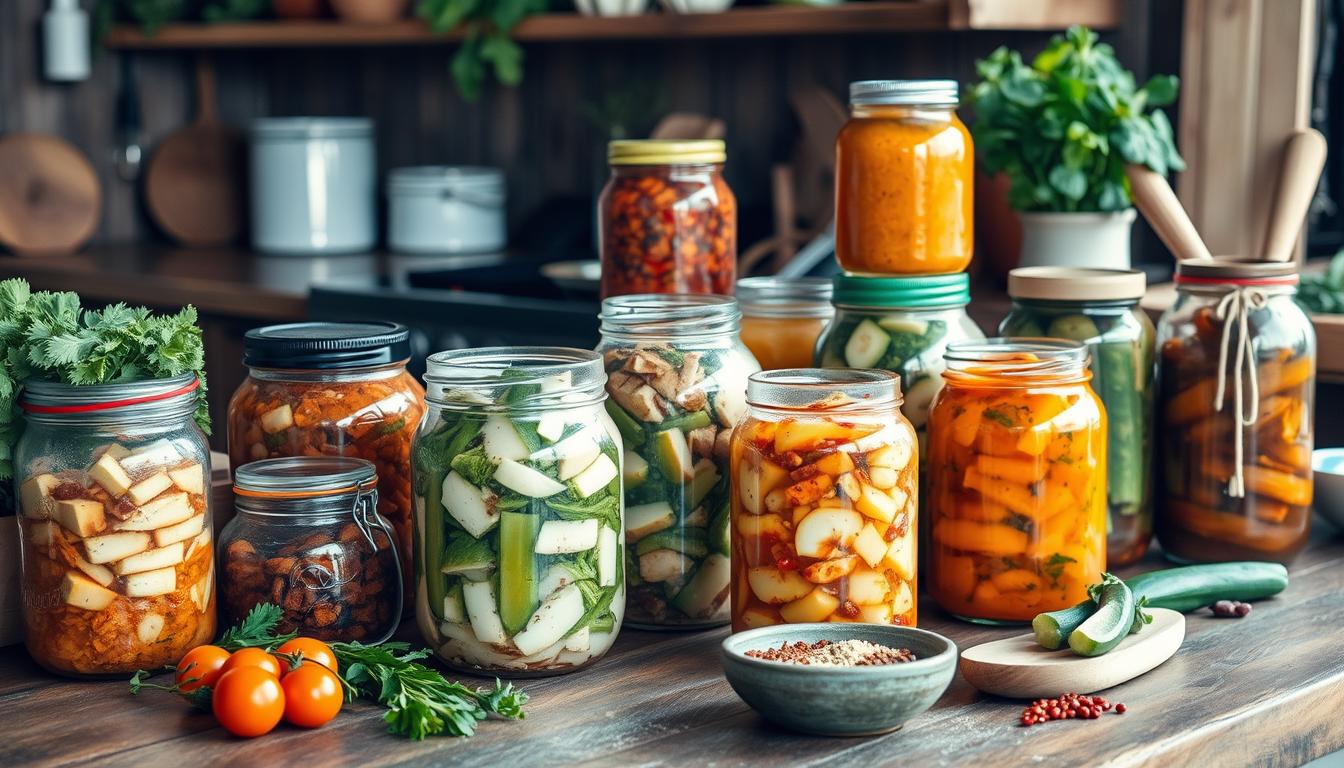I’m excited to share my guide on fermentation and food preservation. This article will cover the history, health benefits, and how to use this method. You’ll learn how to keep your favorite foods fresh and make them taste better.
Fermentation has been key in food making for centuries. It turns simple ingredients into tasty, healthy foods. Sauerkraut and kombucha are just a few examples. Let’s explore the science and benefits behind this method.
This guide is for both new and experienced fermenters. You’ll find tips on starting or improving your fermentation journey. We’ll talk about the tools you need, simple recipes, and the science behind it all. Get ready to master the art of preserving food naturally.
What is Fermentation and Its Importance in Food Preservation?
Fermentation is a fascinating process that has been used for centuries. It involves turning sugars and carbohydrates into simpler compounds by lactic acid bacteria or other microorganisms. This happens without oxygen (anaerobic conditions). It not only keeps food fresh longer but also makes it taste better, feel different, and be more nutritious.
Definition of Fermentation
Fermentation is a metabolic process where microorganisms, like lactic acid bacteria, break down complex compounds into simpler ones. This natural process happens in many foods, like vegetables, dairy, and drinks. It’s key in food preservation and production.
Historical Context of Fermentation
The history of fermentation goes back thousands of years. Ancient civilizations all over the world used it. From making wine in ancient Mesopotamia to sauerkraut in ancient China, it’s been a big part of our food traditions.
Benefits of Fermented Foods
- Improved digestion: Fermented foods have probiotics, which help with digestion and gut health.
- Enhanced nutrient absorption: Fermentation makes some nutrients easier for our bodies to use.
- Extended shelf life: It stops harmful bacteria from growing, so foods last longer.
- Unique flavors: The mix of microorganisms during fermentation creates many tasty flavors.
Fermentation is key in food preservation, changing and improving many foods. By understanding its definition, history, and benefits, we see its value in our food traditions and health.
Types of Fermentation Used in Food Preservation
As a passionate home cook, I’ve explored the fascinating world of fermentation. It’s how we preserve foods, turning simple ingredients into tasty, nutritious treats. Let’s look at the main types of fermentation used in food preservation.
Lactic Acid Fermentation
Lactic acid fermentation is used for veggies, dairy, and some fruits. It involves good bacteria like Lactobacillus, which turns sugars into lactic acid. This makes food last longer, taste better, and get more nutritious. Pickled cucumbers and sauerkraut are great examples.
Alcoholic Fermentation
Alcoholic fermentation uses yeast to turn sugars into ethanol and carbon dioxide. It’s key for making wine, beer, and cider. These drinks can last a long time because of their alcohol. Foods like sourdough bread and some cheeses also use this method.
Acetic Acid Fermentation
Acetic acid fermentation turns alcohol into acetic acid, the main part of vinegar. Acetic acid bacteria do this work. Vinegar is great for preserving foods like pickles, meats, and veggies.
Other Fermentation Processes
There are more fermentation types besides lactic acid, alcoholic, and acetic acid. Mold fermentation is used for cheeses like Roquefort and Brie. Soy sauce, miso, and tempeh use a mix of fungal and bacterial fermentation.
Fermentation lets us keep many foods fresh, from pickling and curing meats to making tasty fermented foods. Each method has its own special benefits. Fermentation is a key part of food preservation.
How to Get Started with Home Fermentation

Are you ready to start a flavorful journey with home fermentation? This ancient method makes tasty, probiotic-rich foods. It also lets you control what goes into your food and keep it safe. Let’s explore the key equipment, simple recipes, and important tips to begin your fermentation adventure.
Essential Equipment for Beginners
You don’t need to spend a lot to start. The basic tools include:
- Wide-mouth mason jars or fermentation crocks
- Airlock lids or cheesecloth for gas exchange
- Weights to keep ingredients under the brine
- A thermometer for checking fermentation temperature
- Chopping boards, knives, and other kitchen tools
Easy Recipes for Beginners
Fermentation is easy to start with. Here are some simple recipes:
- Classic Sauerkraut: Just shredded cabbage, salt, and time for a tangy, probiotic-rich condiment.
- Fermented Pickles: Turn fresh cucumbers into crunchy, tasty pickles with a simple brine.
- Homemade Yogurt: Mix milk and a starter culture for creamy, gut-friendly yogurt.
Tips for Safe Fermentation Practices
While fermentation is natural, it’s key to follow food safety to keep your ferments safe and good. Here are some tips:
- Use clean, sterilized equipment to avoid unwanted microbes.
- Keep an eye on the fermentation, adjusting temperature and time as needed.
- Watch for spoilage signs like off-odors or mold, and toss any bad batches.
- Learn the best pH levels for different fermented foods for food safety.
By following these tips and using fermentation’s natural preservative power, you can make delicious, healthy fermented foods at home. Happy fermenting!
The Science Behind Fermentation

Fermentation is a fascinating process that has captivated many. It’s the transformation of sugars into lactic acid, alcohol, or other compounds by microorganisms. This process can unlock a world of flavor and preservation.
How Microorganisms Contribute to Flavor
Microorganisms in fermentation play unique roles in flavor. Lactic acid bacteria, for example, add a tangy, sour note. Other bacteria and yeasts can add fruity, nutty, or earthy flavors, depending on the strain and conditions.
The Role of Enzymes in Preservation
Enzymes are key in fermentation, breaking down complex molecules into simpler forms. During fermentation, enzymes from microorganisms transform carbohydrates, proteins, and fats. This creates compounds that preserve and flavor the food.
Understanding pH Levels and Their Importance
pH levels are vital in fermentation. They help beneficial lactic acid bacteria grow while stopping harmful ones. Keeping pH levels between 4.0 and 4.6 ensures safe and quality fermented foods.
Exploring fermentation’s science helps us appreciate its complexity. It also makes us more confident in our fermentation efforts. By understanding microorganisms, enzymes, and pH levels, we can create flavorful, nutritious, and preserved foods.
Common Fermented Foods and Their Health Benefits

Fermentation brings us a world of tasty and healthy foods. From kimchi’s tangy taste to yogurt’s creamy texture, these foods are full of good bacteria. They offer many health benefits that are exciting to learn about.
Kimchi and Sauerkraut
Kimchi and sauerkraut are fermented veggies loaded with good bacteria, vitamins, and fiber. They help with digestion, boost the immune system, and can even help with weight. Adding kimchi and sauerkraut to your meals is a tasty way to get more probiotics and feel better.
Yogurt and Kefir
Yogurt and kefir are famous fermented dairy products. They are full of probiotics that keep our gut healthy. Eating yogurt and kefir regularly can help our bones, aid in weight control, and even improve our mood.
Kombucha and Fermented Beverages
Fermented drinks like kombucha are becoming more popular for their health perks. Made by fermenting tea with a SCOBY, they are packed with probiotics, antioxidants, and acids. Drinking kombucha can improve digestion, boost immunity, and give you a natural energy boost.
Adding these fermented foods to your diet is a tasty way to support your health. Try different flavors and textures to see the benefits of probiotics for yourself.
Troubleshooting Common Fermentation Issues
As a home fermentation enthusiast, I’ve faced many challenges. But, with the right knowledge, you can solve even the toughest issues. I’ll show you how to spot spoilage, adjust time and temperature, and fix problems with your ferment.
Signs of Spoilage to Watch For
It’s important to watch your ferments closely for safety. Look for mold, bad smells, or a slimy feel. If you see these signs, throw it out and start again. Always choose caution when unsure.
Adjusting Time and Temperature
The time and temperature of fermentation affect your final product. If it’s too fast or slow, try changing these factors. Test small batches to find the perfect balance for your ingredients and environment.
What to Do When Fermentation Goes Wrong
Even with care, fermentation can sometimes go wrong. If you face issues like pH changes or bad tastes, don’t worry. Take a break, figure out the problem, and fix it. With patience and troubleshooting, you can often save a ferment gone wrong.

